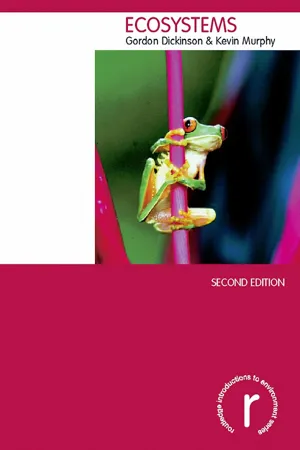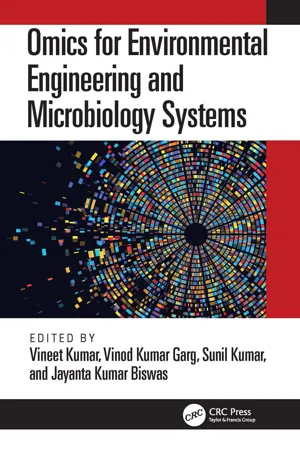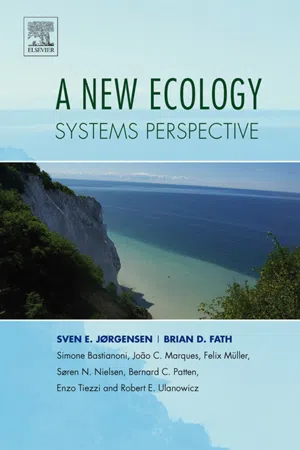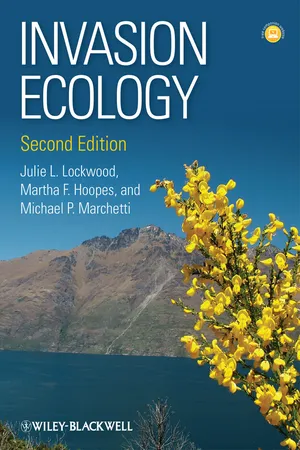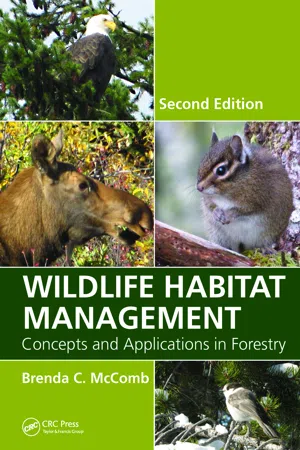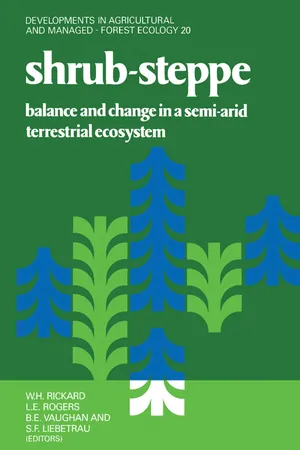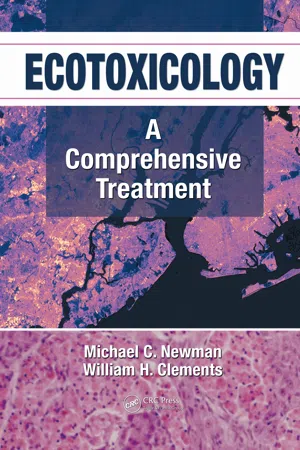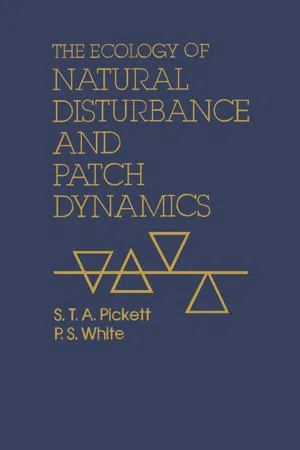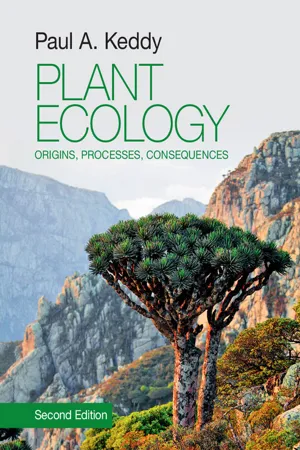Biological Sciences
Ecosystem Disturbance
Ecosystem disturbance refers to any event or process that disrupts the balance of an ecosystem, leading to changes in its structure and function. This can be caused by natural phenomena such as wildfires or human activities like deforestation and pollution. Ecosystem disturbances can have significant impacts on the biodiversity, productivity, and resilience of an ecosystem.
Written by Perlego with AI-assistance
Related key terms
1 of 5
10 Key excerpts on "Ecosystem Disturbance"
- eBook - ePub
- Gordon Dickinson, Kevin Murphy(Authors)
- 2007(Publication Date)
- Routledge(Publisher)
6 The role of disturbance and succession in ecosystem functioning
The abilities to endure unstable conditions and to recover quickly from events that destroy either the habitat or the organisms themselves are the hallmarks of disturbance-tolerant plants, animals and micro-organisms. Disturbance tolerators tend to colonise early in the successional recovery process that follows environmental catastrophes, large or small (from trampling damage on an upland path to volcanic eruptions). Lower-level intensities of disturbance are a commonplace feature of many ecosystems. Successional changes following disturbance events play an important role in the functioning of disturbed ecosystems. This chapter covers:- Defining disturbance
- Succession: community change over time in ecosystems
- Colonisation of lifeless surfaces
- Land–sea interface
- Ecosystem resilience and fragility
Defining disturbance
Ecosystems exist in a constantly changing world. Change results from processes in the abiotic or physical environment, from changes in the biotic environment, the living ecosystem community and by human actions. Disturbance is both a natural and normal part of the environment, but is often increased in scale and accelerated in effect by human impacts. Disturbance is defined as any influence on an ecosystem, which increases the probability of destruction of biomass of the organisms present (see Box 6.1 ). In disturbed ecosystems these influences may be either biotic or abiotic. For example, grazing is a strong disturbance pressure on plants in a prairie ecosystem, but so are abiotic disturbances (e.g. caused by lightning-induced grass fires).Disturbance events affecting ecosystems range from the intermittent and cataclysmic (e.g. a volcanic eruption: see Chapter 2 ), to more permanent and lower intensity pressures, such as the constant effects of disturbance produced by wave action and grazing on marine rocky shore ecosystems.Disturbance affects different ecosystems in different ways. Some species are highly adapted to tolerate disturbance. Disturbance-tolerance adaptations in plants include rapid life cycle, coating of trunks with bark, which is resistant to the high temperatures associated with burning, and rapid regrowth of tissues from intercalary (‘protected’) meristems in response to grazing. The response of a plant community to disturbance will thus be a function of the nature of the disturbance and of the response of the members of that community to particular disturbances. As changes in the biotic and abiotic environment are normal, change in response to natural environmental change is part of the behaviour of ecosystems. Where disturbance is small or cyclical, for example, seasonal or yearly changes in climatic conditions, the response will also be relatively minor. But there are also directional changes which result from what we have identified as natural disturbance. Some of these relate to long-term changes in climate, or to major geomor-phological processes. Others are related to changes that have been brought about by modification of the environment by plant communities. This results in further, directional change to the plant community itself in the process known as ‘succession’. This important concept was introduced in Chapter 1 - Vineet Kumar, Vinod Kumar Garg, Sunil Kumar, Jayanta Kumar Biswas, Vineet Kumar, Vinod Kumar Garg, Sunil Kumar, Jayanta Kumar Biswas(Authors)
- 2022(Publication Date)
- CRC Press(Publisher)
Ummenhofer and Meehl 2017 ). Anthropogenic and natural phenomena may also act synergistically to generate novel and unexpected responses. Therefore, it is a global priority to protect our coastal assets from these environmental impacts. By monitoring the physiology of organisms and the productivity of ecosystems over time, we gain an understanding of the theoretical basis needed to develop better infrastructure and policy that promotes ecosystem health, sustainability, and resilience.18.1.2 Ecological Disturbance Theory
In the scientific literature, the terms “stress” and “disturbance” are used inconsistently and ambiguously. For the sake of clarity, we define a disturbance as a relatively discrete pulse event that at low or intermediate levels of exposure can play a fundamental role in maintaining ecosystem function (Odum, Finn, and Franz 1979 ; Pickett et al. 1989 ; Johnson and Miyanishi 2007 ). When a habitat or patch is made partially or completely devoid of vegetation because of a disturbance, ecological succession begins, and new species will recolonize the cleared area and progressively regenerate species richness and biodiversity (Levin and Painet 1974 ; White and Jentsch 2001 ).We define stress in this chapter as something that puts into action the mechanism of homeostasis (Odum 1985 ; Schulte 2014 ). In this case, a stress response is aimed at maintaining a system’s functionality and stability when faced with environmental changes. Accordingly, the earliest signs of stress in an ecosystem can be detected at the organismal level. If organisms can maintain homeostasis when faced with a stressor by altering their behavior or physiology, a stress response may not be detectable at the population, community, or ecosystem levels. Therefore, stress detectable at the ecosystem level is alarming because it may indicate a breakdown in homeostasis at lower levels of biological organization (Petitjean et al. 2019 ).According to our definitions, ecological disturbances are stressors that are able to alter the physical structure of an ecosystem (Figure 18.1 ). Disturbances in estuaries can be natural, such as tropical cyclones, droughts, freezes, floods, wildfires, and disease, or human-induced, such as oil spills, industrial waste discharges, and dredging. Stress, on the other hand, manifests itself primarily at lower hierarchical levels of biological organization as a response to stressors, while community and ecosystem response times may take longer to detect. For example, coastal vegetation stressed by high winds and flooding during tropical cyclones may lead to mass mortality of plants and subsequent habitat loss for the animals that rely upon that vegetation for food and shelter. In another example, the 2010 Deepwater Horizon oil spill in the Gulf of Mexico set off cascading effects on the entire food web, causing mass mortality of top predators such as marine mammals and seabirds, and in turn, the abundance of the prey species Gulf menhaden (Brevoortia patronus) increased in the absence of predation more than four standard deviations higher than its previous 39-year mean (Short et al. 2017 ). Therefore, disturbances can completely restructure communities and ecosystems through cascading effects up or down the food web, and also from the organismal level to the population and community levels. Moreover, short-lived disturbances can also have long-lasting effects on the abiotic environment (Borja et al. 2010). On the other hand, soil toxicity would impede plant recolonization and growth and thus reduce the ecosystem’s intrinsic resilience to perturbations (El-Shatnawi and Makhadmeh 2001- eBook - ePub
A New Ecology
Systems Perspective
- Sven Erik Jørgensen, Brian D. Fath, Simone Bastianoni, Joao C. Marques, Felix Muller, S. Nors Nielsen, Bernard D. Patten, Enzo Tiezzi, Robert E. Ulanowicz(Authors)
- 2011(Publication Date)
- Elsevier Science(Publisher)
Chronic stress or background environmental variabilities are not included within this definition, although these relations can also cause significant ecosystem changes. If a disturbance exceeds certain threshold values, then flips and bifurcations can occur, which provoke irreversible changes of the system’s trajectory. Therefore, understanding ecosystems requires an understanding of their disturbance history. A focal problem of any disturbance definition is how to indicate the “normal state” of an ecosystem (White and Jentsch 2001) because most biological communities “are always recovering from the last disturbance” (Reice, 1994). For our orientor-based viewpoint it might be appropriate to distinguish the temporal phases during which orientor dynamics are executed from phases of decreasing complexifications caused by exceeding threshold values. Some basic terms from disturbance ecology are introduced in Figure 7.4. Disturbances exhibit certain magnitudes (sizes, forces, and intensities of the events, as variables of the source components), specificities (spectrum of disturbed elements), and severities (the impacts of the events on system properties). They can be characterized by various temporal indicators, such as their spatio-temporal scales, their duration, abruptness, recurrence interval, frequency, or return times. In the literature, exogeneous disturbances resulting from processes outside the system are distinguished from endogeneous disturbances - eBook - ePub
- Julie L. Lockwood, Martha F. Hoopes, Michael P. Marchetti(Authors)
- 2013(Publication Date)
- Wiley-Blackwell(Publisher)
The most commonly cited definition is “any relatively discrete event in time that disrupts ecosystem, community or population structure and changes resources, substrate availability, or the physical environment” (White & Pickett 1985, p. 7). This definition will work for our purposes, as would any definition that includes a change in habitat and resource availability. There is a broad range of events and processes that lead to the sorts of changes encompassed by this definition. This range can be described by the intensity, frequency, duration, predictability, distribution, and synergy of any specific disturbance regime (Sousa 1984; White & Pickett 1985; Petraitis et al. 1989). The intensity of disturbance describes its magnitude and severity. Frequency is the mean number of disturbances in a unit of time. Duration addresses the temporal extent of the disturbance. Predictability describes the regularity of the occurrence and offers insight into how organisms may adapt to the disturbance. Distribution of disturbances is significant in invasion biology because it describes the size and spatial extent of the disturbance and will be important in Chapters 7 and 8 in discussions of geographic range expansion. Finally, synergy describes whether a disturbance precipitates or exacerbates further disturbances. Largely based on these disturbance characteristics, ecologists have devised several dichotomies for classifying disturbances. Disturbances can be natural or human-caused, biotic or abiotic, and originate externally or internally (Sousa 1984; Pickett et al. 1989). Natural disturbances are ones without anthropogenic roots, including such things as hurricanes, floods, and many forms of herbivory or predation. Human-caused disturbances are seen as categorically different from natural disturbances and include things like land-use change, toxic spills, and alteration of flooding regimes - eBook - PDF
Wildlife Habitat Management
Concepts and Applications in Forestry, Second Edition
- Brenda C. McComb(Author)
- 2015(Publication Date)
- CRC Press(Publisher)
79 Disturbance Ecology and Habitat Dynamics Stuff happens: fires, hurricanes, volcanoes, floods, and earthquakes. On average, approximately 450,000 ha are burned in the United States annually, over 1 million ha are affected by hurricanes and over 20 million ha are affected by insects and pathogens (Dale et al. 2001). The economic cost to society is over 1 billion dollars/year in the United States (Dale et al. 2001). To most people, these events are catastrophes. They can kill people, destroy property, and they can be catastrophic for other organisms too. Wind uproots trees, fires burn dead wood, and floods erode streambanks. They can also be events that renew habitat for other species. Indeed biodiversity conservation depends on disturbance. Wind adds dead wood to a forest, fires open the tree canopy and initiate a new for-est, and floods create a new seedbed for willows and cottonwoods. Disturbances to forests have occurred for as long as there have been forests. Animals living in forests have adapted to many of these disturbances and some species rely on disturbances to provide food, cover, and water for survival. Understanding characteristics of disturbances and how disturbances influence habitat ele-ments in stands and over forests can provide information that forest managers can use to provide habitat for selected species or to aid in conserving biodiversity. Knowledge of natural disturbances can help when developing silvicultural systems that might meet the needs of forest-associated wild-life (Franklin et al. 2002). There are several characteristics of disturbances that can be used to understand potential effects on forest development, forest function and the sizes, numbers and distribution of habitat elements: type of disturbance, size and pattern, frequency, and severity. Disturbance type is also important, with changes in habitat elements being quite different depending on the cause of the disturbance (e.g., fire vs. wind). - eBook - PDF
Shrub-Steppe
Balance and Change in a Semi-Arid Terrestrial Ecosystem
- Alec Rickard, L.E. Rogers, B.E. Vaughan, S.F. Liebetrau(Authors)
- 2012(Publication Date)
- Elsevier Science(Publisher)
8.2. Levels of Ecological Organization and Their Attributes J Ecosyste m Leve l C o m m u n i t y Leve l Populatio n Leve l O r g a n i s m Leve l 262 internal ecosystem processes, inputs to the system and subsequent ecological re-sponses is represented in Figure 8.1. This model shows precipitation, nutrients and solar energy as inputs, and the interactions among producers, consumers, decom-posers and abiotic components. Disturbances are translated through the system by way of processes associated with the functioning of the major components, and various responses are produced. The complexity of these functional interactions within the ecosystem influences recovery (Van Voris et al. 1980). The responses shown in Figure 8.1 refer to the kinds of ecological endpoints that ecologists normally measure in trying to determine whether changes are associated with a particular disturbance. These changes may occur at one or more of the levels of organization within the ecosystem (Figure 8.2), i.e., at the organism, population, community or ecosystem level. Some response characteristics typically measured include those for identifying changes in ecological structure (density, biomass, taxonomic composition and diversity) and those for identifying changes in ecologi-cal processes (production, phenology, nutrient cycling rates, energy flow patterns, water balance regimes). Section II. Characterization of Disturbance and Stress in the Shrub-Steppe Ecosys-tem The effects of human-induced disturbances on ecosystems are not necessarily distinct from the effects of natural disturbances. For example, human-induced fire is often difficult to distinguish from fire caused by lightening. Landslides can disturb the soil in a manner similar to construction activities, and intense grazing by wild animals can be similar to grazing by domestic animals. - eBook - PDF
Ecotoxicology
A Comprehensive Treatment
- Michael C. Newman, William H. Clements(Authors)
- 2007(Publication Date)
- CRC Press(Publisher)
25 Disturbance Ecology and the Responses of Communities to Contaminants It is one of those refreshing simplifications that natural systems, despite their diversity, respond to stress in very similar ways. (Rapport et al. 1998) 25.1 THE IMPORTANCE OF DISTURBANCE IN STRUCTURING COMMUNITIES In this chapter, we will compare the ways in which communities respond to natural and anthropogenic disturbances. We suggest that many of the characteristics that determine resistance and resilience of communities to natural disturbance may also influence responses to chemical stressors. For the purposes of this discussion, disturbance is defined as any relatively discrete event that disrupts ecosystem, community, or population structure and changes resources, substrate availability, or the physical environment (White and Pickett 1985). Key features that determine the impact of disturbance on communities are the magnitude (e.g., how far the disturbance is outside the range of natural variability), frequency, and duration. Some ecologists define disturbance as any event that results in the removal of organisms and creates space. Indeed, some ecology textbooks (e.g., Begon et al. 1990) combine discussion of disturbance and predation in the same chapter because they ultimately have similar effects on communities: the removal of organisms from a community. The impact of a predator on a competitively superior species will have a qualitatively similar influence on community structure as the creation of space by physical disturbance. However, most community ecologists limit the definition of disturbance to include only events that are outside the range of natural variability. In other words, the predictability or novelty of a disturbance event greatly influences community responses and recovery times. Predictability of disturbance is largely influenced by the frequency of occurrence, but also varies among ecosystems and disturbance types (Table 25.1). - eBook - PDF
- Judith Rosales(Author)
- 2019(Publication Date)
- Delve Publishing(Publisher)
Human Ecology, Disturbance Ecology, and Altered Ecosystems CONTENTS 8.1. Air Pollutants and Altered Human Environments ............................. 138 8.2. High Surface Area Inorganic Membrane For Process Water Removal ............................................................................ 140 8.3. Wireless Monitoring of Steel Production Facilities ........................... 141 8.4. Changes In Energy Sources ............................................................. 142 8.5. Ecological Changes on Soil and the Influence on Crop Growth ...... 147 8.6. Soil Microorganisms and Their Effects ............................................. 155 8.7. Agroecosystems: Livestock and the Impacts of Mineral Imbalances in Tropical Soils ............................................ 156 8.8. Factors Influencing Soil Mineralogy ................................................ 159 8.9. An Evaluation on Major Elements and Trace Elements Required by Livestock .................................................................. 161 8.10. Forage Plant Composition and Mineral Imbalance in Grazing Animals .......................................................................... 168 CHAPTER 8 Altered Ecosystems 138 An alteration or disturbance is “ any event relatively discrete in time that alters the structure of an ecosystem, the community or the population and changes the resources, availability of substrate or the physical environment .” Some disturbances have been causing effects for centuries and decades but especially after the industrial revolution with increasing damage to the biodiversity and the physical environments that are considered a high risk at the beginning of the XXI century with important alteration of human ecology and human survival as a species. 8.1. AIR POLLUTANTS AND ALTERED HUMAN EN-VIRONMENTS Air pollutants are considered those that contaminate the atmosphere greatly. - Bozzano G Luisa(Author)
- 2012(Publication Date)
- Academic Press(Publisher)
Heterotrophic Respiration and Net Ecosystem Productivity 344 III. Conclusion—Disturbance, Energetics, and Resource Management 349 IV. Summary 351 Recommended Readings 352 I. INTRODUCTION Changes in ecosystem energetics due to natural disturbance have been discussed much less than changes in nutrient cycling or species diversity. One reason for this may be the difficulty and expense of doing field research on energetic parameters. A comprehensive study of ecosystem energetics for even a single site is a massive undertaking, and extending the study to cover an entire successional sequence requires either a very felicitous experimental situation (Peet and Christensen, 1980; Cooper, 1981; Sprugel, 1984) or very large financial resources (Reichle, 1981). About a dozen studies have looked at temporal trends in the simpler energetic parameters such as biomass accumulation and net primary productivity (see below), but only one or two have considered less tractable parameters such as ecosystem •Present address: College of Forest Resources, AR-10, University of Washington, Seattle, Wash-ington 98195. THE ECOLOGY Copyright © 1985 by Academic Press, Inc. OF NATURAL DISTURBANCE All rights of reproduction in any form reserved. AND PATCH DYNAMICS ISBN 0-12-554520-7 335 336 Douglas G. Sprugel respiration or net ecosystem productivity. Moreover, nearly all of the studies have dealt with boreal coniferous forests, in which a high natural disturbance frequency and low human impact make it possible to find acceptable age sequences of stands. The following discussion will include some hypotheses concerning less-studied parameters and ecosystems, but the need for additional research is great. A second reason for the lack of attention to ecosystem energetics is that, viewed in the short term, disturbance effects on ecosystem energetics may seem less drastic than effects on other ecosystem properties.- eBook - PDF
Plant Ecology
Origins, Processes, Consequences
- Paul A. Keddy(Author)
- 2017(Publication Date)
- Cambridge University Press(Publisher)
FIGURE 5.41 Some common disturbances plotted along two axes, area and intensity. Note that further down on the vertical axis means a greater decline in the amount of biomass, and greater change in the vegetation. These areas are all approximations, of course. Consider grazing. As drawn, it causes moderate changes in vegetation over relatively large areas (see Figure 6.1 to imagine the landscape). If carried out long enough, by enough animals, grazing will indeed remove all the biomass and create deserts, a topic we will return to under goat grazing ( Box 13.2 ). 208 Disturbance Review Questions 1. Which ecoregion do you live in, and what kind of natural disturbance was prevalent in your ecoregion 1,000 years ago? 2. What are the four properties of disturbance? Contrast an animal burrow with a landslide using these four properties. 3. What is the natural fi re return frequency in your landscape? Make some predictions about what might happen if this frequency were either increased or decreased. 4. Explain how rivers create new habitats. 5. What is a seed bank? How is it related to disturbance? Can you fi nd data for seed densities in your local vegetation types? 6. Explain how the different kinds of disturbance in the Everglades create the array of vegetation types found there (review Figure 5.40 ). Find a published local example illustrating similar principles. Or, create such a drawing for your own landscape. Further Reading Connell, J.H. 1978. Diversity in tropical rain forests and coral reefs. Science 199 : 1302 – 1310. Grime, J.P., G. Mason, A.V. Curtis, J. et al.1981. A comparative study of germination characteristics in a local fl ora. Journal of Ecology 69 : 1017 – 1059. Sousa, W.P. 1984. The role of disturbance in natural communities. Annual Review of Ecology and Systematics 15 : 353 – 391. Pickett, S.T.A and P.S. White. 1985. The Ecology of Natural Disturbance and Patch Dynamics . Orlando: Academic Press. Salo, J., R. Kalliola, I. Hakkinen et al.
Index pages curate the most relevant extracts from our library of academic textbooks. They’ve been created using an in-house natural language model (NLM), each adding context and meaning to key research topics.
